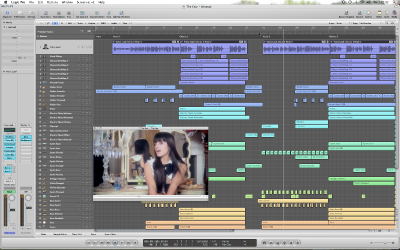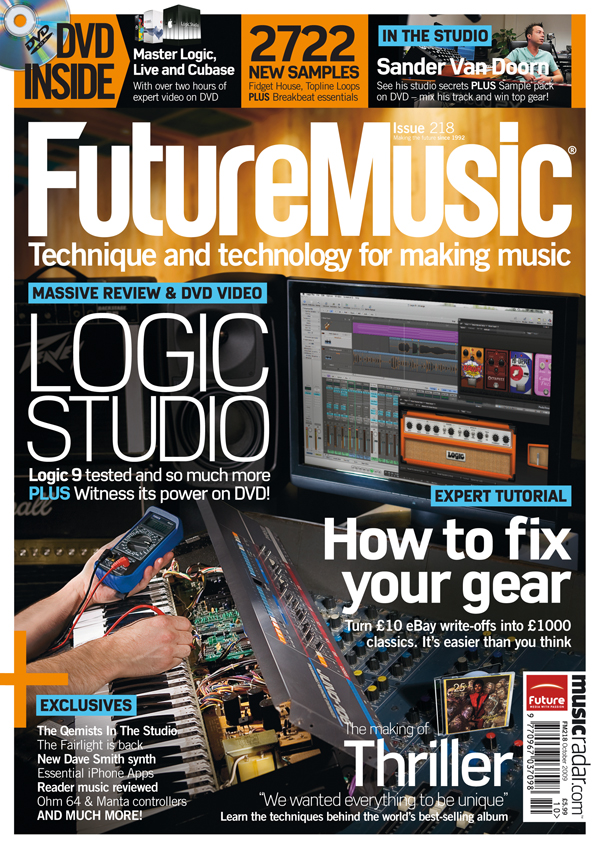Logic Studio: The FM Review
The latest issue of Future Music,
, features the definitive review of Logic Studio. As a taster for the goodness to come here are choice highlights from our massive feature. To get your copy of the mag, click the link above.
Logic Studio replaces its previous incarnation on the shelves. It contains the same core programs as before - Logic Pro, MainStage, Soundtrack Pro, Studio Instruments and Effects - but has upgraded each with new features so that Logic Pro moves to Version 9, MainStage to Version 2 and so on. Regardless of what type of music maker you are, there´s something for you in Logic Studio.

What´s New For Producers?
Logic Pro 9´s single biggest producer-based feature is Apple´s embracing of ‘elastic time´ editing which has been enjoyed by Live users for eons and Pro Tools users since the release of version 8. Separately, some subtle but important changes have been made to work-flow and the look and feel of the program, many of which have clearly responded to user feedback, as some of the most common requests have finally been integrated, such as ‘instant´ audio quantise.
Flex time
Push audio around, change note lengths, move phrases, beat slice, integrate audio at different speeds in seconds, quantise audio, impose the groove of a kick drum onto a bassline, record audio at a slower tempo before instantly speeding it back up to full speed - Flex Time has arrived and not before time. It delivers pretty much anything and everything you´ve wanted and lets you complete jobs in Logic that previously required exporting to Ableton Live.
Drum Replacer
You can see this in action on our cover-mounted DVD free with the magazine, but suffice to say that the opportunity to turn a single track of drums into a velocity-mapped MIDI region for the EXS24 is going to be great news for everyone with access to a great drummer but a poor microphone collection or acoustically limited recording space. The provision of a set of multi-sampled kicks, snares and toms ready to roll with this feature is very neat too and one I wouldn´t be surprised to see this tailor-made library expand further in the future.
Want all the hottest music and gear news, reviews, deals, features and more, direct to your inbox? Sign up here.
Convert to Sampler
Turning an audio region into a REX-style sampler instrument is now dead easy thanks for the dedicated ‘Convert Regions To New Sampler Track´ from the Audio menu. This will analyse transients in a loop and convert each slice to its own ‘note´ within a MIDI region in the EXS24. You´re then free to edit this as you would any bit of MIDI, with alternative quantise, a modified musical pattern or synthesis parameters within the EXS24 itself. Great for turning tired loops into brand new material.
Expanded Take Editing
Logic 8´s take editing and comping features are hugely popular but they´re not without issues. In particular, it was frustrating having to complete and ‘flatten´ a comp before going to work on editing it and copying comp regions was impossible until they were ‘committed´ too. Now, it´s possible to temporarily disable ‘quick swipe comping´ while looking at the various takes you´ve recorded and, with the view expanded, copy, move or ‘Flex edit´ regions before switching back into ‘Comp´ mode to complete your selections.
Selective Track Import
Via the Media Browser, it´s now possible to browse into other projects on your hard disc and select individual tracks from within. That isn´t the cool part though. The cool part is that you can tick boxes to select content, plug-ins, auxiliary sends and even I/O routing and anything you select will then import with all selected settings. So, if you´ve got a killer bassline which combines a soft synths, some EQ and distortion and an aux delay, you can bring the whole lot in, as one, without leaving your current project or needing to save channel strip settings.
Bounce In Place
Here´s a feature many of us have been clamouring for. Finally, it´s possible to select a single region and bounce it as an audio file. This is great as a way to capture sound with effects for one off ‘treatment moments´ or when working with third-party plug-ins such as Melodyne. When selecting this option, there´s even a handy ‘capture the effects tail´ option so that regions don´t unnaturally chop the ends off your sounds.

What´s New For Guitarists?
It´s no exaggeration to say that this is Logic´s most significant update for guitar-based producers ever. For starters, there are two new plug-ins squarely aimed at axe-wielders in the form of Amp Designer and PedalBoard. Read all about both below and don't miss the videos on our cover-mounted DVD to see them in action. There are now thousands of tab chords added to the Score Editor while MainStage 2 offers Playback and Loopback, two tools designed to get you jamming. MainStage also lets you configure and use Amp Simulator and PedalBoard to your heart´s content and both Logic and MainStage benefit hugely from the options offered by the new Apogee GiO interface.
Amp Designer
Guitarists are among the biggest beneficiaries to Logic Studio 2. Amp Designer borrows heavily from plug-ins like Guitar Rig but while it´s not as complete a plug-in, it´s less CPU intensive and for all those who don´t yet own an amp simulator, this could well forgo the need for an additional purchase.
PedalBoard
Check out the magazine's DVD to see PedalBoard in action. GarageBand 09´s inclusion of stomp effects might have started rumours about whether Logic was set to provide similar effects control but I´m not sure anyone could have predicted 30 effects which could be chained together in series and parallel to bring a touch of live guitar effect performance to Logic.
Loopback
Loopback provides the chance to record a layered performance one loop at a time, with each playing back at the end of a predetermined length before the next is added. Anyone who remembers the old Lexicon JamMan will know exactly what I mean!
Apogee GiO interface
GiO integration gives Guitarists a bespoke interface for transport and PedalBoard control and, as it packs Apogee´s high quality pres in its capacity as an interface, stands a decent chance of becoming ‘the´ interface for guitar-based Logic heads.
Notation
For those still dealing in notes on a page, Logic´s Guitar Notation and Tab Chords library has expanded hugely, providing over 4,000 chord grids and score symbols for ornaments and bends. Development in this area might seem a tad surprising as I think it´s fair to say it´s a niche, but there are so many TV and film composers using Logic these days that I´m sure those previously resigned to a switch to Sibelius or its competitors will prick up their ears.

What´s New For Performers
Only two versions ago, the idea of using Logic on stage was a risky game. Now though, with MainStage, Logic´s stage presence is growing fast.
Mainstage
MainStage has moved onto version 2 and comes bundled with some new features which take it up a fair few notches. For starters, the two standout features are the Playback and Loopback tools, which are expanded upon below. Thereafter, ReWire support is now provided so that you can use MainStage in conjunction with programs such as Live and Reason. You can now record performances (or entire DJ sets) directly inside MainStage and it´s now much easier to assign and group controllers for real-time instrument and effect tweaking. Setting up your entire gig as different combinations of effects, instruments and backing tracks has never been easier, and you can simply tap to the next complex set up with a click of the mouse or a button push on your controller keyboard. Yes, you can play live with Logic!
Playback
This dedicated MainStage plug-in does what it says on the tin, letting you grab an audio file and play it back alongside whatever else you have going on in Logic. If you want to commit certain parts of a performance to a stereo mix and jam over the top you can. This will benefit everyone, from buskers to stadium-filling bands who want to add live playing to pre-preared backing tracks.
Loopback
Select a cycle length and punch in for instant capture and playback. A great live tool and a great ‘ideas´ pad.

What else is new?
Content, effects and instruments-wise, there isn´t a raft of new content in Logic 9. Amp Designer and PedalBoard aside, you won´t find any new effects, though SpaceDesigner has been updated with 450 new ‘warp´ effects, which are effectively a series of weird Impulse Response programs through which any sound can pass. These include musical tones and chords, as well as processed sound effects, so if you want to add some ‘left of centre´ quality to your sounds, this is for you.
All of Apple´s Jam Packs are now integrated too, which means that the vocal phrases for which Logic has been crying out are now yours. Some producers are sniffy about the Loop content but they can afford to be much less so now with Flex and Audio Quantise. As a result of this technology, every audio loop within Logic can be ‘bent´ to become whatever you need it to be in terms of feel and performance, so this library has just become a lot more relevant.
Conclusion
I´ve been a Logic user for as long as I can remember but, as a producer, I´m thrilled by the new tools and feature set in Logic Studio. The integration of Flex editing is powerful and intuitive but above all, fast, meaning that you can try ‘out there´ editing, often in real-time and decide whether or not it´s working before you even get to the first chorus. This update makes so many long-winded tasks super-fast and intuitive that you can just get on with making great music and as a tool-set for production, I don´t think any program betters Logic for that.
For the full review check out our October Issue, 218, on sale now and available at www.myfavouritemagazines.co.uk
